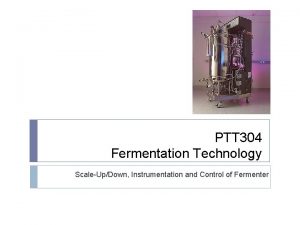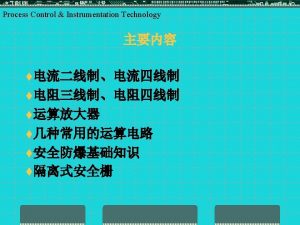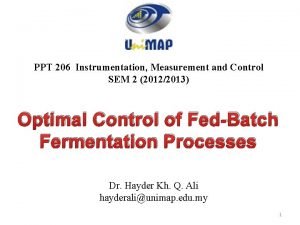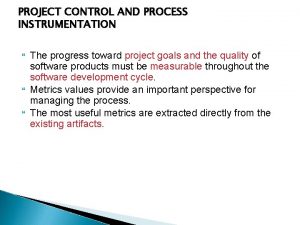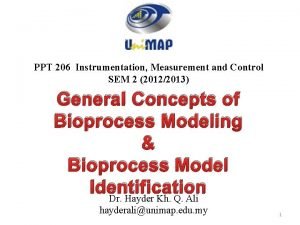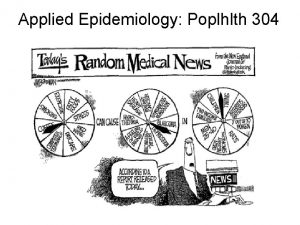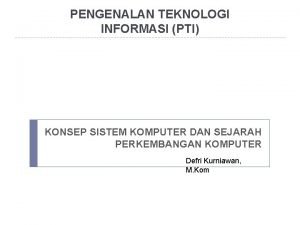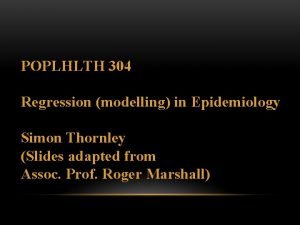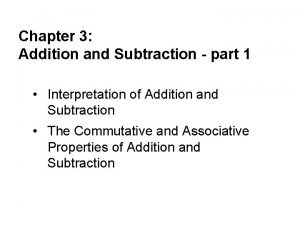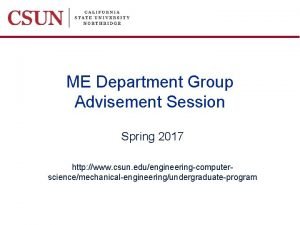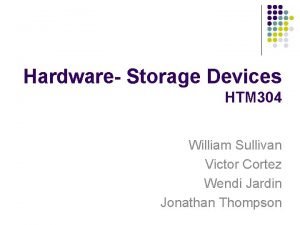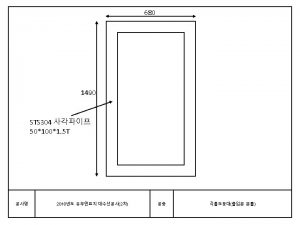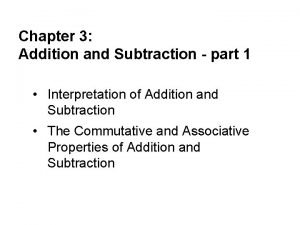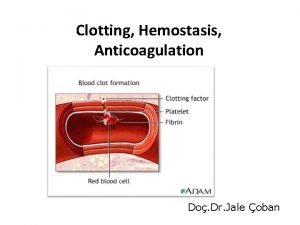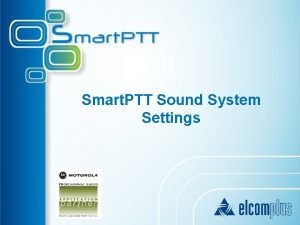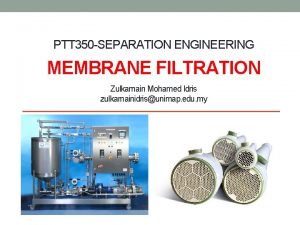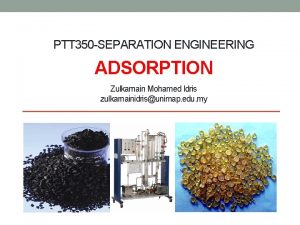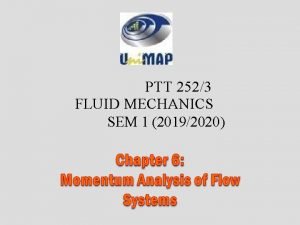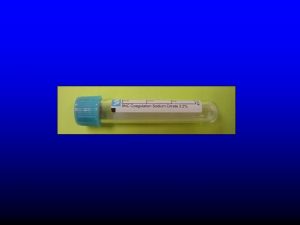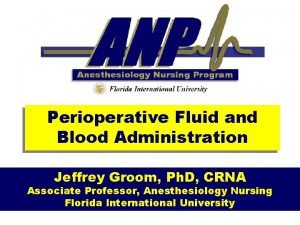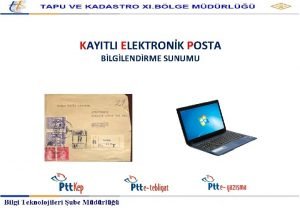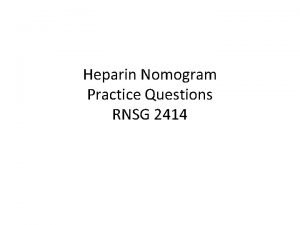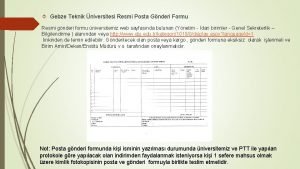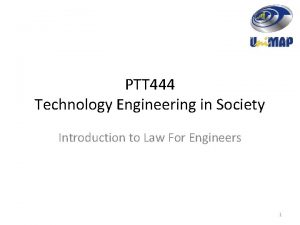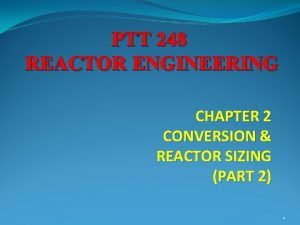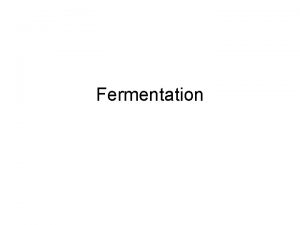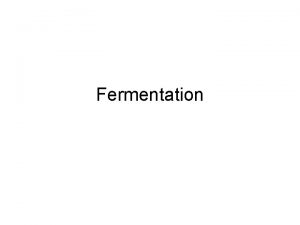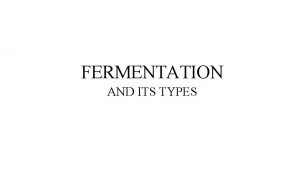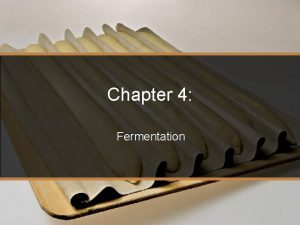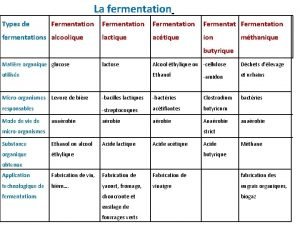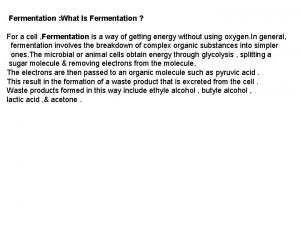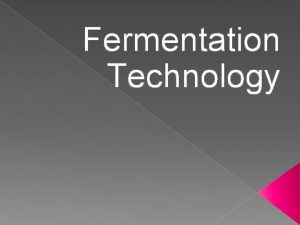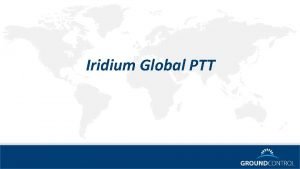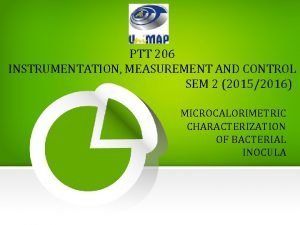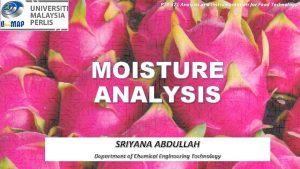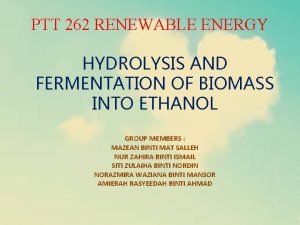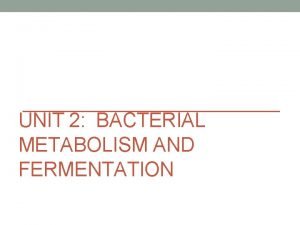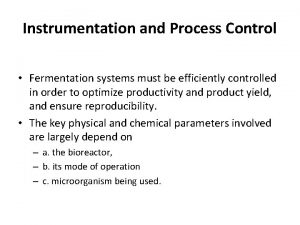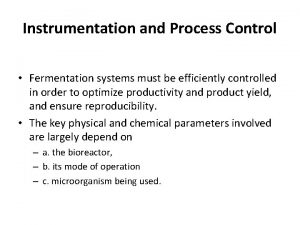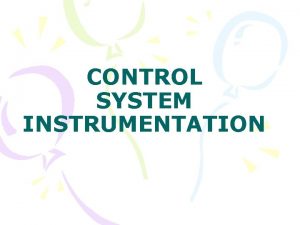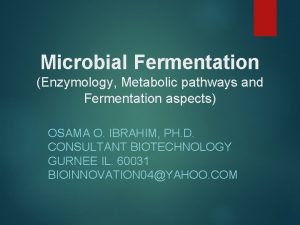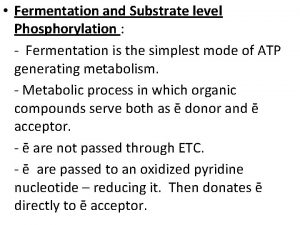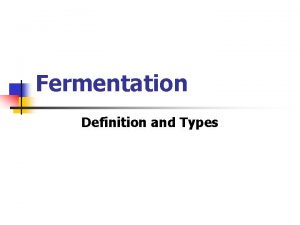PTT 304 Fermentation Technology ScaleUpDown Instrumentation and Control









































- Slides: 41

PTT 304 Fermentation Technology Scale-Up/Down, Instrumentation and Control of Fermenter


SCALE UP Increasing the scale of a fermentation which means increase in volume Problems due to process parameters are affected by the size of the unit. Scale up can involve 1. 2. 3. Inoculum development- extra stages Sterilization-scale dependent as number of microorganims must be reduced to the same absolute numbre Environmental parameters such as nutrient, p. H, tempertaure, DO, shear conditions, foam production—all these parameters are affacted by agitation and aeration

SCALE UP It is unlikely to replicate the conditions of small scale precisely Hence, important criteria must be established.

SOLUTION FOR SCALE UP PROBLEM Identification of the principal environmental domain affected by aeration and agitation in the fermentation -O 2, shear, bulk mixing Identification of a process variable which affects the identified environmental domain Calculation of the value of the process variable to be used on the large scale.





Scale up Procedure from Laboratory Scale to Plant Scale • The criteria of scale up from lab scale to plant scale are: 1. Similar Re number or momentum factors 2. Constant power consumption per unit volume of liquid 3. Constant impeller tip velocity 4. Equal liquid mixing and recirculation time 5. Constant volumetric of mass transfer coefficient 6. Keep all environmental factors for the microorganism constant

Different important Dependent variables used in Scale up

SCALE DOWN • Laboratory or pilot scale experiments are conducted under conditions that mimic the industrial scale conditions. • Important for new product development and improvement of an existing full scale fermentation

SCALE DOWN 1. Media design 2. Medium sterilization-sterilization on smaller scale should be increased to mimic the larger scale 3. Inoculation procedures-using inoculum of different ages 4. Number of generations-modelled in the laboratory by using serial sub-culture to ensure the strain is stable.

5. Mixing the degree of mixing will decrease with an increase in scale. Thus. it is possible to model inadequate mixing in the laboratory by subjecting the organism to pulse medium feeds or fluctuating process conditions such as oxygen concentration , p. H and temperature. Such scaled down experiments then allow predictions to be made about the suitability of new strains for industrial exploitation. 6. Oxygen transfer rate • (Far higher oxygen transfer rates can be achieved in laboratory Fermentors than in industrial-scale ones. Thus, unrealistic demands may be made of a fermentation plant if the development work has been done at very high oxygen-transfer rates. Therefore, the laboratory and pilot. Fermentors should reflect the oxygen transfer rates achievable in the full-scale Fermentors. )

EXAMPLE Consider the scale-up of a fermentation from a 10 l to 10000 l vessel. The small fermenter has a height-to-diameter ratio of 3. The impeller diameter is 30% of the tank diameter. Agitator speed is 500 rpm and three Rushton impellers are used. Determine dimensions of large fermenter and agitator speed for a. Constant P/V b. Constant impeller tip speed c. Constant Reynolds number Assume geometric similarity.



PROCESS CONTROL

• On-line also in-situ measurement is the measurement taking in or near the reactor during operation, less time consuming however, incurred cost for installation of such system. (ie. Temperature, p. H, dissolved oxygen rate, pressure) • • Off-line measurement the samples must be removed from the reactor and taken to the laboratory for off-line analysis, it is time consuming but less consumption of installation cost and avoid maintenance cost (especially for maintenance of the control sensor). (ie. biomass, protein, carbohydrate, enzyme activity etc. )

CONTROL SYSTEMS • The basic principle of control involves a sensory system linked to a control system and feedback loop. • Sensors are used to measure and record the events within the bioreactor. • In conjunction with process control, they maintain the difference between the measured and desired values at a minimum level. • Overall control can be manual or automated; newer systems have integral and derivative control systems. • Data recorded from the sensors and control decisions are downloaded to a computer where appropriate calculations can be per-formed to determine production of biomass and product, overall oxygen and carbon dioxide transfer rates, nutrient utilisation, power usage, etc.


CONTROL SYSTEMS • All of this information may be used to construct a mathematical computer model of the process. • If a deviation is discovered, appropriate alarm and correctional systems are activated, giving greater control of the fermentation. • Any control system needs to be calibrated when first installed and then regularly checked to conform to good manufacturing practices (GMP).

Scheme for controlling fermenter temperature

Control Systems • The process parameters may be controlled using control loops. • A control loop consists of four basic components: 1. A measuring element. 2. A controller. 3. A final control element /actuator. 4. The process to be controlled.

CONTROL SYSTEMS A Feedback Control Loop In the simplest type of control loop (feedback control): • The measuring element senses a process property (flow, pressure, temperature, etc) then generates corresponding output signal. • The controller compares the measurement signal with the set point and produces an output signal to counteract any differences between the two.

CONTROL SYSTEMS • The final control element receives the control signal and adjusts the process by changing a valve • opening or pump speed and causing the controlled process • property to return to the set point.

CONTROL SYSTEM • The process parameters which are measured using probes may be controlled using control loops • A control loop consists of 4 basic components: A measuring element A controller A final control element The process to be controlled

FIG 2: A FEEDBACK CONTROL LOOP Disturbance Output Controller Controlling element Measuring device Process

�The simplest type of control loop – feedback control �The measuring element senses a process property such as flow, pressure, temperature, etc. �Then, generates a corresponding output signal �The controller compares the measurement signal with a predetermined desired value (set point) �Thus, produces an output signal to counteract any differences between the two �The final control element receives the control signal and adjusts the process by changing a valve opening/pump seed �Cause the controlled process property to return to the set point

Manual Control • A simple example is manual control of a steam valve to regulate the temperature of water flowing through a pipe. • Labor, cost and should be kept minimum and use automated control as much as possible. Simple manual control loop for temperature control

AUTOMATIC CONTROL • When an automatic control loop is used, certain modifications are necessary. • The measuring element must generate an output signal which can be monitored by an instrument. • E. g. thermometer is replaced by a thermocouple, which is connected to a controller which in turn will produce a signal to operate the steam valve. Simple automatic control loop for temperature control

COMPUTER APPLICATIONS IN FERMENTATION TECHNOLOGY • Three distinct areas of computer function were recognized: 1. Logging of process data. • Data logging is performed by the data acquisition system which has both hardware and software components. • There is an interface between the sensors and the computer. The software should include the computer program for sequential scanning of the sensor signals and the procedure of data storage. 2. Data analysis (Reduction of logged data). • Data reduction is performed by the data-analysis system, which is a computer program based on a series of selected mathematical equations. • This analyzed information may then be put on a print out, fed into a data bank or utilized for process control.

COMPUTER APPLICATIONS IN FERMENTATION TECHNOLOGY 3. Process control. • Process control is also performed using a computer program. • Signals from the computer are fed to pumps, valves or switches via the interface. • In addition the computer program may contain instructions to display devices to indicate alarms, etc. • There are two distinct fundamental approaches to computer control of fermenters. • 1) Fermenter is under the direct control of the computer software. This is termed Direct Digital Control (DDC). • 2) The use of independent controllers to manage all control functions of a fermenter and the computer communicates with the controller only to exchange information. • This is termed Supervisory Set-Point Control (SSC).

Process Control • Three levels process control that might be incorporated into a system were recognized. • Each higher level involves more complex programs and needs a greater overall understanding of the process. • The first level of control, involves sequencing operations, such as manipulating valves or starting or stopping pumps, instrument recalibration, on-line maintenance and fail-safe shut-down procedures. • In most of these operations the time base is at least in the order of minutes, so that high-speed manipulations are not vital. • Example is sterilization cycles in fermentation processes.

Process Control • The second level of control involves process control of temperature, p. H, foam control, etc. where the sensors are directly interfaced to a computer, Direct Digital Control (DDC). • When this is done separate controller units are not needed. • The computer program determines the set point values and the control algorithms • Computer failure can cause major problems unless there is some manual back-up facility.

Process Control Layout of computer- controlled fermenter with only one control loop

PROCESS CONTROL • The alternative approach is to use a computer in a pure supervisory role, All control functions are per-formed by an electronic controller using a system illustrated in the figure:

PROCESS CONTROL • In such a system the linked computer only logs data from sensors and sends signals to alter set points when instructed by a computer program or manually. • This system is known as Supervisory Set-Point Control (SSC) or Digital Set. Point Control (DSC). • When SSC is used the modes of control are limited to proportional, integral and derivative because the direct control of the fermenter is by an electronic controller. • In the event of computer failure the process controller can be operated independently.

Process Control • The third (advanced) level of control is concerned with process optimization. • This will involve understanding a process, being able to monitor what is happening and being able to control it to achieve and maintain optimum conditions. • Firstly there is a need for suitable on-line sensors to monitor the process continuously. • A number are now available for dissolved oxygen, dissolved carbon dioxide, p. H, temperature, biomass (the bug meter, NADH fluorescence, near infra-red spectroscopy) and some metabolite (mass spectroscopy and near infra-red spectroscopy).

Process Control • Secondly, it is important to develop a mathematical model that adequately describes the dynamic behavior of a process. • This approach with appropriate on-line sensors and suitable model programs has been used to optimize bakers’ yeast production, an industrial antibiotic process and lactic acid production.

 Ptt 304
Ptt 304 Process control instrumentation technology
Process control instrumentation technology Instrumentation and control systems ppt
Instrumentation and control systems ppt Seven core metrics of software project
Seven core metrics of software project Basics of instrumentation and control ppt
Basics of instrumentation and control ppt Geneva 304 hac
Geneva 304 hac Poplhlth 304
Poplhlth 304 Cmsc 304 umbc
Cmsc 304 umbc Ncr serie 304
Ncr serie 304 Iis 304
Iis 304 Poplhlth 304
Poplhlth 304 Describe a way to calculate 304 81 mentally
Describe a way to calculate 304 81 mentally Csun previously disqualified questionnaire
Csun previously disqualified questionnaire 3 storage devices
3 storage devices Crs 19-3-304
Crs 19-3-304 Premier poc03m
Premier poc03m Sts304 pipe
Sts304 pipe Allie solves the subtraction problem 304-9 as follows
Allie solves the subtraction problem 304-9 as follows Ptt heparin
Ptt heparin Difference between submerged and solid state fermentation
Difference between submerged and solid state fermentation Cellular respiration in the mitochondria
Cellular respiration in the mitochondria Robert williams ptt
Robert williams ptt Ptt levels
Ptt levels Ptt test high
Ptt test high Acquired thrombophilia
Acquired thrombophilia Ptt tw drama
Ptt tw drama Ptt sound
Ptt sound Ptt circuit
Ptt circuit Ptt-350
Ptt-350 Ptt-350
Ptt-350 Angular ptt
Angular ptt Pt vs ptt
Pt vs ptt Ptt normal range
Ptt normal range One drive
One drive Ptt kep aktivasyon
Ptt kep aktivasyon Twitter
Twitter Heparin math questions
Heparin math questions Iade taahhütlü posta
Iade taahhütlü posta Pt aptt
Pt aptt Introduction to engineering in society
Introduction to engineering in society Paz1k
Paz1k Thurs ptt
Thurs ptt
